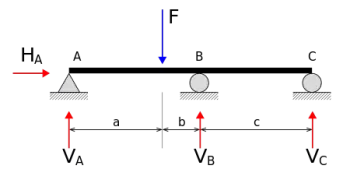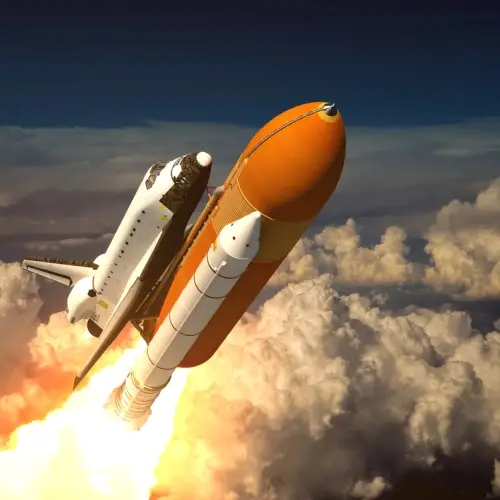
Newton's third law (or principle of action and reaction) is the last of the three fundamental laws of dynamics developed by Sir Isaac Newton along with the law of inertia (1a) and the fundamental law of dynamics (2a). These laws explain much of the aspects relating to the motion of bodies.
Newton's third law states that:
“Every action is always opposed by a reaction of equal value, or the mutual actions of two bodies on each other are always directed towards the opposite part.”
Explanation of the law of action and reaction
 That is, if a force is exerted on a body a, the body a will respond with another reaction force of equal magnitude and opposite direction.
That is, if a force is exerted on a body a, the body a will respond with another reaction force of equal magnitude and opposite direction.
Newton's first two principles (the law of inertia and the fundamental law of dynamics) refer to a single body. The third law, on the other hand, refers to the interaction between two bodies.
Generally, when we talk about the third law we express the F of force with two subscripts: the first one is to indicate the body that exerts the force, while the second subscript is used to refer to the body on which the force acts.
If, for example, we have two bodies a and b that exert forces on each other, F ab represents the force that body “a” exerts on body “b”. Similarly, F ba represents the force that body “b” exerts on “a”: that is, the force exerted by “b” on “a”.
Newton's third law states that these two forces are equal and opposite.
Forces occur in pairs, that is, there cannot be a single force applied to an isolated body.
This law is independent of whether the objects are at rest, in motion, or in uniform rectilinear motion.
The law of action-reaction applies both in situations of direct contact (for example, when we push a table) and in interactions at a distance (such as the gravitational force between two bodies). The action and reaction forces do not cancel each other out because they act on different objects.
The third law is also linked to important concepts such as the principle of conservation of momentum . This principle states that in the absence of external forces, the total momentum of an isolated system remains constant. For example, when a rocket expels gases downward, the ship is pushed upward, which ensures momentum equilibrium.
What is the action-reaction pair?
The action-reaction pair are the two forces exerted between two bodies that interact with each other.
Two bodies that exert a force on each other are two objects that interact with each other. Newton's law of action and reaction establishes the relationship between the two forces resulting from the interaction of two bodies. For this reason, the two forces F ab and F ba are sometimes called an action-reaction pair. One of the forces is called the action and the second is called the reaction.
The choice of which force plays the role of action or reaction is an arbitrary decision.
Examples of Newton's third law
 Below are some examples of the third law :
Below are some examples of the third law :
- A book at rest: A book lying on a table exerts a force on the table due to gravity. At the same time, the table exerts a normal force with the same magnitude but opposite direction to compensate this force. Due to this reaction force the book will remain at rest.
- The connection of a train engine to its wagons: A train engine exerts a force on the wagon attached to it in the direction of travel. At the same time, the wagon exerts a reaction force in the opposite direction, opposing the travel.
- Walking: When you walk, your feet push the ground back, and the ground pushes you forward.
- Swimming: By pushing the water back with your hands, the water propels you forward.
- Rocket takeoff: The gases expelled downwards generate a force that pushes the rocket upwards.
- Rowing a boat: By pushing the water backwards with the oars, the boat moves forward.
- Hitting a ball: When you hit a ball, you exert a force on it, and this applies a counterforce on the racket or foot.
- Jump on the ground: Your legs push the ground down, and it pushes you up.
- Crashing a car into a wall: The car exerts a force on the wall, and the wall exerts an equal force on the car.
- Pushing a table: When you push it, the table pushes you back.
- Landing an airplane: The airplane's wheels apply a downward force on the runway, while the runway pushes them upward.
- Throwing a stone: When you throw a stone, your hand applies a forward force, while the stone applies a force in the opposite direction on your hand.
Technological applications of the third law
 Newton's third law is applied in many technological applications, particularly propulsion and engineering. One of the most notable examples is rocket propulsion. A rocket works by expelling gases at high velocity downwards; this is the action. In response, according to the third law, the rocket is pushed upwards with a force equal in magnitude but in the opposite direction, allowing it to take off and fly.
Newton's third law is applied in many technological applications, particularly propulsion and engineering. One of the most notable examples is rocket propulsion. A rocket works by expelling gases at high velocity downwards; this is the action. In response, according to the third law, the rocket is pushed upwards with a force equal in magnitude but in the opposite direction, allowing it to take off and fly.
The same principle applies to jet propulsion used in airplanes. Engines expel gases backward, which generates the thrust that propels the plane forward. Without the third law, the motion of these aircraft and other vehicles powered by jet engines would not be possible.
Another field where this law has important applications is nuclear engineering. In nuclear reactors, the energy released by the fission of atomic nuclei generates heat, which converts water into steam. This steam is expelled into a turbine, which generates the reaction force needed to produce electricity.
These applications demonstrate how the third law is fundamental to the design and operation of advanced technologies that power mobility and energy generation today.